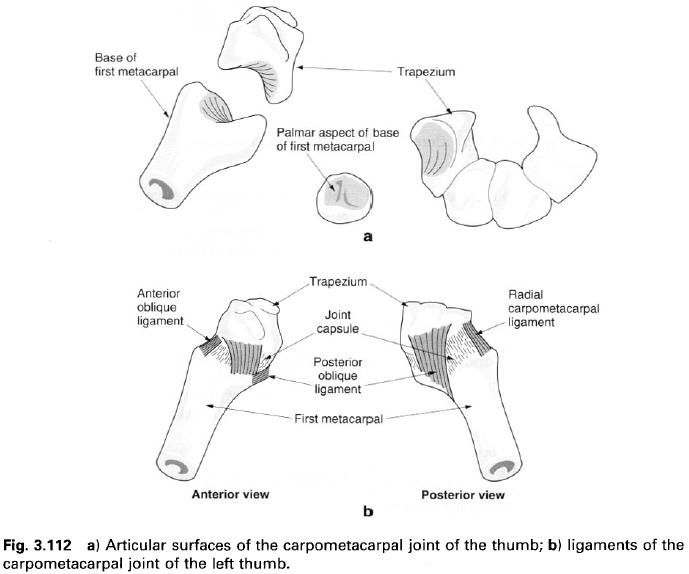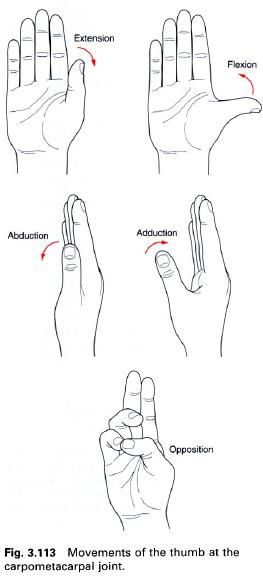The thumb is an extremely mobile and
specialized digit, both of which are important prerequisites for the movement
of opposition, and for the normal prehensile functioning of the hand.
Carpometacarpal joint
The carpometacarpal joint of the thumb,
although extremely mobile, nevertheless provides a stable base from which it
can effectively and efficiently work. It plays a vital role in movements of the
thumb allowing movement in three dimensions.
Articular
surfaces
The joint is between the trapezium and the base
of the first metacarpal(picture a). It provides the best example in the body of
a synovial saddle joint, with the two surfaces being reciprocally concavoconvex
and covered with hyaline cartilage.
The articular surface of the trapezium is
concave more or less in an anteroposterior direction, and convex perpendicular
to this. The base of the first metacarpal has reciprocal curvatures. The
concavities and convexities of the surfaces do not lie strictly within the
transverse and anteroposterior planes, as will become evident when the axes
about which movement occurs are considered.
Joint capsule and synovial membrane
A loose but strong fibrous capsule compeletely
encloses the joint, attaching to the articular margins of both bones(b). It is
lined with synovial membrane. The capsule is thickened laterally by the radial
carpometacarpal ligament, and anteriorly and posteriorly by anterior and
posterior oblique ligaments.
Ligaments
The radial carpometacarpal ligament passes between
the adjacent lateral surfaces of the trapezium and first metacarpal(b).
The anterior and posterior oblique ligaments
pass from their respective surfaces of the trapezium to the medial side of the
first metacarpal, converging as they do so(b). The posterior oblique ligament becomes taut in flexion of the
thumb, while the anterior becomes taut during extension.
Blood
and nerve supply
The arterial supply to the joint is by branches
from the palmar and dorsal carpal
networks, while its nerve supply is by twigs from the anterior and posterior interosseus nerves, root value C7, 8.
Relations
The carpometacarpal joint of the thumb lies
deep to the thenar muscles, which cover its anterior aspect. Medially is the
tendon of flexor pollicis longus and
laterally the tendons of extensor pollicis longus and brevis.
Stability
The joint is principally stabilized and the
surfaces kept in opposition by the tone of the muscle whose tendons cross the
joint. The shape of the articular surfaces and the looseness of the fibrous
capsule allow the joint its large degree of mobility, and hence play only a
minor role in its stability.
Movements
Because of the thumb is rotated approximately
90° with respect to the plane of the hand,
the terminology used to describe its movements appears at first to be
confusing. The terms flexion, extension, abduction and adduction are used as if
the thumb were in line with the fingers. That this is not so can be clearly
seen when observing your own hand;
the thumbnail faces almost laterally while the finger nails face posteriorly.
Thus flexion and extension occur in a coronal plane, as does abduction and
adduction of the remaining four digits; and abduction and adduction occur in a
sagittal plane, as do flexion and extension of the other digits. Due to the
nature of the joint surfaces and the looseness of the capsule, a certain amount
of rotation is also possible at the joint. Because movements at the joint are
brought about in the main by muscles whose tendons lie parallel to the metacarpal,
compression across the two opposing surfaces always accompanies the movements.
Consequently, the joint surfaces tend to grind against each other, instead of
there being simple rolling or gliding.
Flexion
and extension. This occurs in
the plane of the palm of the hand, so
that flexion in thumb moves medially and in extension it moves laterally(figure
below). The axis about which the movement occurs passes through the base of the
metacarpal at the centres of curvature of the concave trapezium and the convex
metacarpal. It does not lie exactly in an anteroposterior plane but is set
slightly obliquely from posterior, lateral and proximal to anterior, medial and
distal.
The total range of flexion and extension is
between 40° and 50°. Towards the end of full flexion, tension developed in the
posterior oblique ligament results in a medial rotation of the metacarpal
causing the palmar surface of the thumb to face posteriorly. Conversely,
towards the end of full extension, lateral rotation of the metacarpal occurs
because of tension developed in the anterior oblique ligament. Flexion at the
joint occurs as a secondary movement of flexor pollicis longus and brevis acting on the interphalangeal and
metacarpophalangeal joints respectively. Similarly extension is due to the
actions of extensor pollicis longus and brevis as they act on the interphalangeal and metacarpophalangeal joints
respectively.
Abduction
and adduction. Both occur at
right angles to the palm so that in abduction the thumb is carried forwards away
from the palm and in adduction it is moved back towards the palm(figure above).
The axis about which movement occurs is perpendicular to the axis of flexion
and extension. It passes through the trapezium at the centers of curvature of
the concave metacarpal and convex trapezium, and runs slightly obliquely from
medial, posterior and distal to lateral, anterior and proximal.
The range of abduction and adduction is about
80°, with adduction being brought about by adductor pollicis pulling on the proximal phalanx. Abduction is brought about by the
direct action of abductor pollicis longus on the joint, and by the secondary
action of abductor pollicis brevis
acting on the metacarpophalangeal joint.
Opposition. This is described as a movement in which the
distal pad of the thumb is brought against the distal pad of any of the
remaining four digits(picture above). It is an essential movement of the hand, and its loss markedly reduces the
functional capacity of the hand. The movement is complex involving flexion, abduction
and rotation followed by adduction at the carpometacarpal joint, as well as
movements at other joints of the thumb.
Essentially, opposition consists of three
elementary movements. Initially, flexion and abduction of the thumb occur
simultaneously at the carpometacarpal joint due to the action of flexors pollicis longus and brevis and abductor pollicis longus. This produces
a certain amount of passive axial rotation of the metacarpal, possible because
of the looseness of the joint capsule – the rotation is directed medially due
to the posterior oblique ligament becoming taut. At some point during this
movement, opponens pollicis contracts
to produce an active rotation of the metacarpal – this is the second elementary
movement. Finally, adduction occurs at the carpometacarpal joint, produced by adductor pollicis, to bring the
metacarpal back towards the plane of the palm of the hand.
Movements of the thumb at the
metacarpophalangeal joint contribute significantly to the overall movement of
opposition. At the same time as the carpometacarpal joint is being flexed and
abducted, so is the metacarpophalangeal joint. Again the simultaneous movments
of flexion and abduction of the proximal phalanx bring about a degree of axial
rotation at this joint. Consequently, the pad of the thumb comes to face
posteromedially.
Returning the thumb to the anatomical position
has no specific name. It is brought about mainly by the contraction of the
extensor muscles of the thumb. Perhaps it should therefore be referred to as
exposition.











0 коментара:
Постави коментар